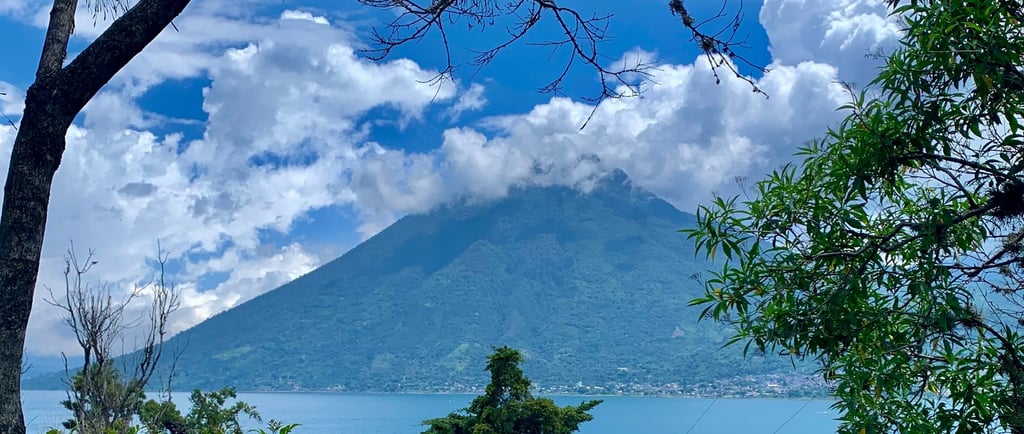Things to Know Before You Go to Lake Atitlán, Guatemala


Lake Atitlán Should Be on Your Radar
Lake Atitlán is located in southwest Guatemala and occupies an area of about 130 square kilometres or 95 square miles - and is about 340 meters or 1220 feet deep. It is about 1500 meters or 5000 feet above sea level and was created by a series of volcanic eruptions beginning millions of years ago. The last major lake-forming eruption is thought to have occurred about 85,000 years ago, causing the volcano to collapse after erupting - creating a large crater-like depression in the earth that filled with water from nearby rivers and eventually became the Lake Atitlán we see today.
After this last major eruption, the three volcanoes we see around the lake formed, including Atitlán (3537 metres), Toliman (3158 metres), and San Pedro (3020 metres). Volcano Atitlán is still active, while the other two are inactive volcanoes.
Most of the local population around the lake are Kaqchikel and Tz’utujil, two Mayan groups that have maintained much of their culture, identity and languages due to their relative isolation from mainstream Guatemala.
Archeological evidence suggests that lakeside communities extend as far back as 1000-600 BC, about the time the Mayan civilization began. One of the most intriguing archeological findings occurred quite recently in 1998 when a scuba diver accidentally discovered ancient Mayan ruins submerged underwater in the lake (dating back to 400-250 BC). This site is now known as Samabaj and was built on a small island in the middle of the lake. The island and the ancient Mayan ruins are thought to have disappeared beneath the surface after a volcano erupted and increased the water levels significantly. This discovery has been called the Mayan Atlantis and theories suggest that the island was once a site of religious pilgrimage for the ancient Mayans.
Today, the lake continues to be a sacred place of deep spiritual significance for the local Mayans - and many foreign spiritual seekers have been called to its magical shores to seek contemplation, meditation, transformation, and healing. Over the years, ancient Mayan beliefs and traditions have mingled with many imported spiritual practices, making the lake a major destination for spiritual seekers from all around the world.
The lake has been characterized by spiritual seekers in many different ways, such as:
the centre of the universe where earth, sky and underworld converge;
a portal to other dimensions;
a sacred energy vortex with great healing power; and,
a realm of spiritual energy capable of profound transformation.
For the local Mayans, several places around the lake are imbued with sacred energy, where shamans continue to host ancestral worship, healing rituals and fire ceremonies.
Spiritual seekers from around the world come to participate in local Mayan ceremonies as well as a wide range of imported spiritual practices, such as yoga, meditation, reiki, sound healing, crystal healing, and ayahuasca ceremonies - to name just a few.
But the lake is not only for spiritual seekers.
Lake Atitlán also offers many outdoor recreational activities, such as swimming, scuba diving, kayaking, paddle-boarding, hiking (including volcano hiking), mountain biking, and rock climbing. The lake setting for these outdoor activities is stunning.
Regardless of whether you come as a spiritual seeker, an outdoors enthusiast, or merely a curious traveler seeking culture, or rest and relaxation, most visitors agree that Lake Atitlán is a beautiful and magical destination that should be on every traveller's radar.
Check out the Wander Yonder YouTube video below for a short video featuring an overview of four of the villages surrounding the lake (including Panajachel, San Pedro, San Juan and San Marcos) to help you decide which village to base yourself.
Lake Atitlán is Generally Safe for Tourists
I stayed at an Airbnb just outside the main tourist area in the town of Panajachel and never felt unsafe during the day or at night during my month-long stay. According to many blog posts I read, other visitors staying at many of the other towns around the lake, such as San Pedro, San Juan, and San Marcos, also felt safe during their stays.
Although Lake Atitlán is generally considered to be a safe area, it does experience petty crime like most tourist areas. Be mindful of your belongings and surroundings at all times - and avoid doing anything that will make you a target, including wearing expensive jewellery, or flashing your expensive phone or camera, particularly while you are outside of the main tourist areas around the lake. Extra precaution should always be taken at night to avoid being alone on dark and empty streets.
Lake Atitlán is Located at High Altitude
Lake Atitlán has an average altitude of about 1500 meters (5000 feet) above sea level. Upon arrival, and particularly if you hike any of the surrounding volcanoes at higher altitudes, you may experience symptoms of altitude sickness, such as shortness of breath, tightening of your chest, headache, dizziness, nausea, fatigue, problems with sleep and loss of appetite. Symptoms usually begin within 12 to 24 hours of reaching higher elevation and get better within a day or two after your body adjusts.
In higher elevations, your body needs to work harder to maintain blood oxygen levels, increasing your respiration rate and leading your body to lose water faster than at sea level. Your risk of dehydration increases significantly. Places at higher altitude also have lower humidity, compounding the risk for dehydration. Drinking more water than usual is very important to alleviate symptoms and prevent dehydration. Health experts suggest increasing your water intake by an additional 1 to 1.5 litres for a total of 3-4 litres a day.
The Tap Water is Not Safe to Drink
Most people know that tap water is not safe to drink in Guatemala. However, many hotels and Airbnbs around the lake include drinking water as part of their services for guests through large refillable water containers or built-in water filter systems. I suggest asking if drinking water is included before you book a place around the lake.

